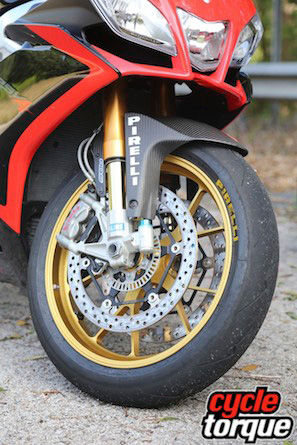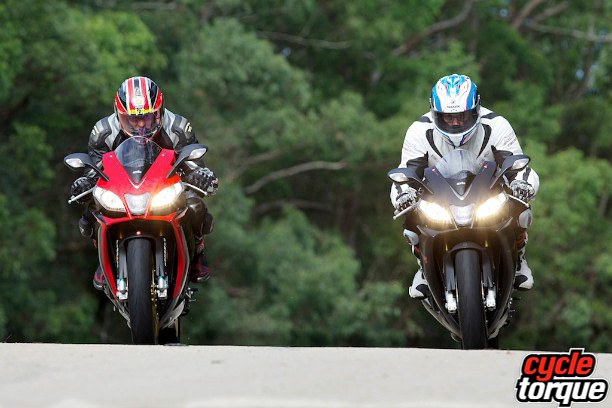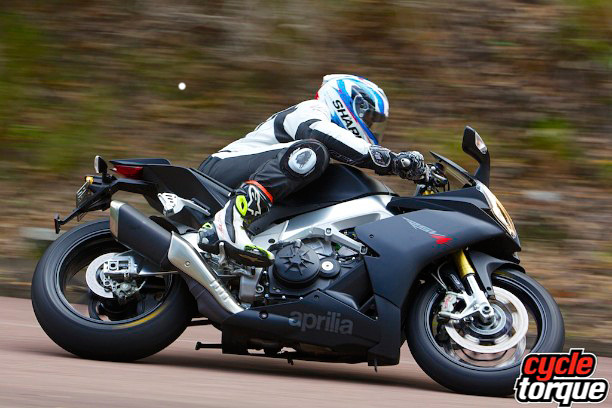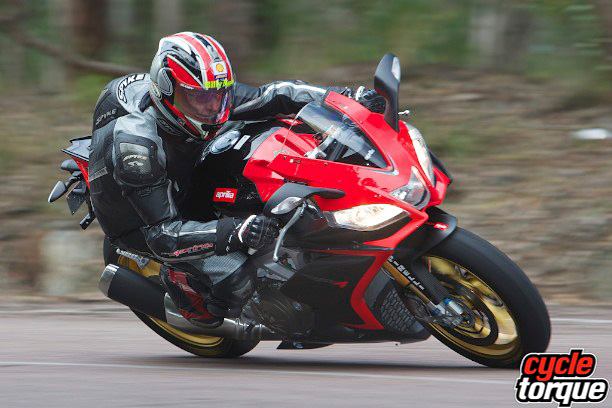IT’S NOT often you get to test two similar models from the same manufacturer back to back but that’s exactly what we did with the Aprilia RSV4 R APRC and its more exotic, and more expensive stable-mate, the RSV4 Factory APRC. Which one you would choose will come down to the folding stuff you possess I think.
Those with a penchant to stand out from the crowd would go for the Factory, and those who are looking for an edge on the road and/or track would also go the Factory. But as I said, that’s if they have the appropriate boost in available coin.
Most riders, I honestly don’t think would tell much of a difference when they are at the controls blasting down a bit of swervery. In that arena both bikes are simply amazing to ride, and have abilities the average sports rider could never really hope to harness.
On the racetrack maybe, but on the road… RSV4 R For 2013 the base model – it sounds crazy calling this a ‘base’ model – has a number of improvements over the previous one.
The chassis has been altered for better handling (like it needed it?) and the power has been increased to 184 from the 1000cc V-Four engine.
Both bikes have the APRC package, which stands for Aprilia Performance Ride Control. In a nutshell what this package gives the rider is traction control which constantly changes to suit your lean angle, how hard you are twisting the throttle, and even how tight the corner is.
This is done by adjusting the throttle butterflies, not altering the spark, therefore according to Aprilia the ‘intervention’ is smoother. Well, no arguments here.
You also get wheelie control which sometimes isn’t a bad thing because the bike would be climbing over its back sprocket with gay abandon if it didn’t. This is done not by how high the front wheel is in the air but by measuring front and rear wheel speeds, acceleration and G-forces. A bit complex maybe but it does work.
Launch control is more designed for the racetrack than the road, and this uses a combination of the traction control and wheelie control to let you get better starts. Most racers know that your front wheel clawing the sky isn’t conducive to good starts, as you need to back off the throttle to get better forward drive. Launch Control stops this.
Another great track tool, but something which is fun on the road too, is the quick shifter. It works quite seamlessly and is a great racetrack tool. Lots of racers fit them as an aftermarket accessory, but it comes standard on the the RSV4 R.
Right from the get go ride-by-wire technology has allowed Aprilia to give the rider power delivery choices which is a fantastic thing. On the RSV4 R you can choose between Road, Sport and Track.
Obviously you get more aggressive power the more track focused option you choose. For example, you get softer low down power when in Road mode than you do in Sport mode, and so on. ABS comes standard and it has selectable positions, which can be turned off.
You can choose between road and track ABS options, making this bike one of the most electronically exotic on the road. Besides that, the four-piston monoblock Brembo calipers and 320mm discs will just about pop your eyeballs out through your visor if you’re not careful.
The suspension is a mix of 43mm Showa forks which, as you would expect, are very very adjustable. Likewise, the Sachs rear shock is full of compression and rebound ‘clickers’ for those who like to tailor their riding experience.
It’s light too, at 184 kg dry you won’t have many issues pushing this bike around the shed, or back it into the footpath at the cafe. You’ll look bloody good doing it too I reckon.
Now most riders of an RSV4 are not going to worry too much about fuel range but it is an issue. Fuel tank size is 18.5 litres and this will get you 200 kilometres or thereabouts depending on how brave you are with the throttle and/or the fuel light. Power costs, and the more power, the more fuel is required to get it. People on a budget need not apply. I’m not saying it’s expensive to run, just don’t expect commuter level fuel economy.
Colour choices are black or white. Price is $21,990 + ORC
RSV4 Factory
Essentially the platform is the same. Engine specification is no different from the RSV4 R, nor is the look, apart from the graphics and paint scheme of course.
You should notice the different forks and wheels, and this is where most of the extra cost comes from.
Ohlins suspension is fitted all round, still 43mm forks though.
Brakes are the same, probably because they don’t need to be any better, but the wheels and suspension do give the bike the edge over its cheaper sibling, when riding closer to the edge so to speak.
Overall the bike is some five kilos lighter than the ‘R’ due to the lighter wheels and carbon fibre parts. In the very near future you can expect to see the ADD, and no it’s not what your out of control child has. It stands for Aprilia Dynamic Damping which is basically active suspension.
We sampled this recently with the Aprilia Caponord, and can attest to how good it is. Watch this space I reckon.
Price is $27,990
Road attitude
Attitude is certainly what the bike gives the rider, it’s got a very ‘sports’ riding attitude, and you feel a bit special when you are riding either bike.
Both are very good but you can feel the quality of the Ohlins suspension, and also the ‘turnability’ of the ‘Factory’ which is fitted with the lighter magnesium wheels.
Both bikes handle extremely well anyway, and they go the same, which is like stink. And when you open the taps both bikes sound absolutely glorious, with a roar only a V-Four engine can produce. I’ve always loved the RSV4 range simply for the engine, and it’s one of the great things which sets them apart from the competition
They are more comfortable than you might think too. You are perched on top somewhat but the relationship between the seat/’pegs/’bars was not as punishing as I expected.
Stability is top rate too, no matter if you are pulling the brake lever as hard as you can, you are at sphincter puckering lean angles, or you are gassing it up on the exit of a corner, either bike just takes it in its stride.
All the rider aids do work as they are intended, which is not something I can say about every bike I’ve ridden with such an intensive electronics package.
Overall
For pure performance and desirability it’s hard to look past the RSV4 Factory, even with the price difference between the models.
I’m not sure racers would stump up the extra moolah for the Factory, seeing as they would be stripping it anyway, but then again the attraction is the suspension and lighter wheels are already there. Buy a RSV4 R and start putting trick suspension and wheels on it and you’d be up at the Factory price anyway
I think who buys each bike will come down to what’s inside them personally rather than startling differences between the two bikes. The RSV4 is a great bike, and the Factory is just that bit better.







Be the first to comment